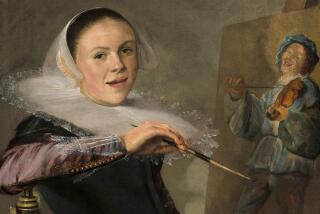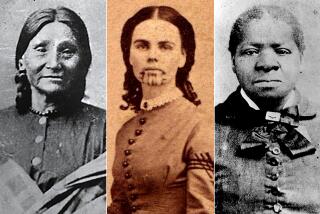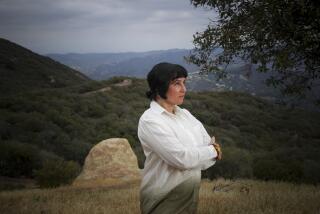60 curious, brave women travelers
- Share via
London — Linguist, writer, archeologist and intelligence agent Gertrude Bell was one of the first women to travel alone in the Arabian desert in the early 20th century. She made such an impression on a sheik that, when seeking her later, he asked a passing Bedouin, “Have you seen a queen traveling?”
Along with 59 other footloose Englishwomen, Bell is the subject of “Off the Beaten Track: Three Centuries of Women Travellers,” a special exhibition I recently visited at the National Portrait Gallery on Trafalgar Square. The museum, with a collection begun in 1586, showcases famous faces, from staid oil portraits of Tudor kings to a recent video of British soccer star David Beckham asleep in bed.
For the record:
12:00 a.m. Sept. 10, 2004 For The Record
Los Angeles Times Friday September 10, 2004 Home Edition Main News Part A Page 2 National Desk 0 inches; 19 words Type of Material: Correction
Her World -- The Her World column in Sunday’s Travel section misidentified polar explorer Ernest Shackleton as Edward Shackleton.
For The Record
Los Angeles Times Sunday September 19, 2004 Home Edition Travel Part L Page 3 Features Desk 0 inches; 25 words Type of Material: Correction
Her World -- The Her World column in the Sept. 5 Travel section incorrectly reported the first name of polar explorer Ernest Shackleton as Edward.
The women travelers, who traveled between 1660 and the 1960s, are hardly as famous as Beckham, though their images are part of the National Portrait Gallery collection, if not permanently on display. “ ‘Off the Beaten Track’ celebrates people who can’t be on the walls all the time,” curator Clare Gittings said.
Until now, interest in women travelers has focused on writers, she said. Readers of “Her World” columns may recall some of these: Victorian writer-illustrator Marianne North, whose work appears at the Royal Botanical Gardens, Kew; and Rose Macaulay, author of the hilarious 1956 novel “The Towers of Trebizond,” set in Turkey. I keep close at hand a copy of “The Virago Book of Women Travelers,” edited by Mary Morris and Larry O’Connor, because a female traveler never knows when she might need a bracing sip of Alexandra David-Neel’s “My Journey to Lhasa” or M.F.K. Fisher’s “Long Ago in France.”
Some of the exhibition’s subjects -- Bell, Isabella Bird Bishop, Freya Stark, Mary Kingsley, Agatha Christie -- achieved a certain degree of renown because of their books and the outlandishness of their adventures.
Others were unfamiliar to me, such as Caroline of Brunswick, abandoned wife of King George IV; journalist Flora Shaw; and photographer Constance Gordon Cumming. Many of these lesser-known female travelers went abroad demurely as the wives of diplomats, scientists, explorers and colonial administrators of the British Empire, sending home letters about life and customs in exotic places and pretty watercolors of botanical specimens.
They were dilettantes, adventuresses, eccentrics, nurses, journalists, aviators, women of a certain age just come into money and refugees from convention, the marriage market, loneliness and boredom.
There were libertines and moral crusaders, such as dark-haired actress Fanny Kemble, who, visiting America on tour, was so appalled by the institution of slavery that she left her husband, a Southern planter.
Some were motherless, but more often they were tomboys who doted on their fathers.
They were women of contradiction. Bell and Kingsley, for instance, met hair-raising dangers with aplomb but still opposed universal female suffrage.
What did they share? As Jan Morris says in the introduction to “Off the Beaten Track: Three Centuries of Women Travellers,” the volume that accompanies the exhibition, “What they all had in common was their gender and their guts.” Morris figures in the exhibition, a singularly interesting female traveler who was a male traveler before a sex change in 1972. So I can only believe her when she writes, “I have reached the conclusion, on the whole, that during my own traveling years the female traveler has had it easier than the male. Women are generally no threat to anyone, women are still more likely to be helped, women retain their own immemorial methods of persuasion, and most importantly, women are more likely to fall among friends, allies or colleagues wherever they go -- to this day the human sorority is stronger than the fraternity.”
The exhibition is organized by the common destinations of English women who have traveled during the last 300 years: Africa, the Americas, the Pacific, Far East and the Indian subcontinent. But the sandy kingdoms of the Middle East offered a special challenge and attraction to women travelers, seeking to breech the gates of Islam, as Bell did when she couldn’t get home to England for her younger sister’s wedding because she was busy excavating at the palace and mosque of Ukhaider in Iraq.
In 1913, Bell, who counseled the British foreign ministry on geopolitics in the Middle East just before World War I, was made a member of the Royal Geographical Society. Bishop had been inducted in 1892 by officials, but when the general membership was consulted, the decision to admit women was reversed. At the time, the geographical society was a classic male bastion that thought women too simple to make contributions to the geographical science.
That interested me. So after seeing the National Portrait Gallery show, I visited the Royal Geographical Society.
The society occupies a red brick Victorian building right out of “David Copperfield” that overlooks Hyde Park and Royal Albert Hall, with statues of African missionary David Livingstone and polar explorer Edward Shackleton on the facade.
Until recently, it was a private precinct and allowed in only its 13,500 accredited members, a third of whom are women. But in early June, it completed an addition, including an exhibition space and reading room, open to visitors. Thus, somewhat tardily, the world’s premier geographical institution has invited the public in, as it somewhat tardily invited in great women travelers in 1913. Casual visitors still can’t go into the main Victorian hall, with its African tree trunk underneath which Livingstone’s heart was buried. But if you ask in the reading room, a librarian will bring out the pith helmet Livingstone wore when he shook hands in the African wilderness with explorer Henry Morton Stanley. The sight of it, I was told, made one visitor from California cry.
I feel a little like crying when I think that the travels of men and women -- Livingstone and Kingsley, Shackleton and Bell -- a hundred years ago can’t be replicated, because getting around the world has become too easy.
Or has it? Can’t we still go to places our friends wouldn’t dream of visiting? Can’t we drink thick black coffee with Bedouins, like Bell? Can’t we feel the world meeting us in a wave, even if we go only as far as Jamaica or Hawaii?*
*
Details
Art show: “Off the Beaten Track: Three Centuries of Women Travellers” National Portrait Gallery, St. Martin’s Place, London WC2H OHE; 011-44-20-7312-2463, www.npg.org.uk.
Royal Geographical Society:
1 Kensington Gore, London SW7 2AR; 011-44-20-7591-3000, www.rgs.org.
Susan Spano also writes “Postcards From Paris,” which can be read at www.latimes.com/susanspano. You may e-mail her at postcards@latimes.com. She cannot respond individually.
More to Read
Sign up for The Wild
We’ll help you find the best places to hike, bike and run, as well as the perfect silent spots for meditation and yoga.
You may occasionally receive promotional content from the Los Angeles Times.






